|
|

Handbook on Viewing Buddhist Statues
A totally wonderful
book by Ishii Ayako.
Some images
at this site were
scanned from this
book; Japanese
language only;
192 pages;
80+ color photos
Click here to
buy book at Amazon
Sanskrit Characters
Tobifudo (J-site) |
|

Zōchōten 增長天
King of the South, Lord of Spiritual Growth
Associations = South, Summer, Fire, Prosperity, Red
ORIGIN = Hindu deity incorporated into Buddhism.
Member of the TENBU, SHITENNŌ, DEVA
One of Four Heavenly Kings Who Guard East, West, North, South
Governed by Taishakuten (Skt. = Indra), Lord of the Center
|
Japanese Mantra
おん びろだきゃ やきしゃ
ぢはたえい そわか
On Birodakya Yakisha Jihataei Sowaka (or)
On Birodakya Yakisha Jihataei Sowaka
|
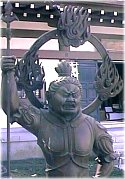
Zōchōten at Hase Dera, Kamakura.
Modern, Metal. Click image to enlarge.
|

Sanskrit Seed
for Zōchōten
Pronounced
BI or VI in Japan
|
ZŌCHŌTEN 増長天 literally means “lord who expands, lord who enlarges.” This is sometimes translated as Sprouting Growth, to indicate Zōchōten’s role as a catalyst of spiritual growth. Zōchōten is one of the four Shintennō, a group of fierce-looking (忿怒相 funnusō) guardian deities who protect the four cardinal directions. In artwork, the four typically surround the central deity on Buddhist altars. Zōchōten protects the southern quarter. Like the other members of the Shintennō group, Zōchōten is dressed in armor (yoroi 鎧) and standing atop a demon (jaki 邪鬼). Zōchōten is often depicted holding a halberd in the right hand, with the left hand clenched on the hip. However, the deity’s attributes are not rigidly prescribed. The oldest statue of Zōchōten in Japan (see photo below), dated to the middle 7th century, is located at Hōryūji Temple 法隆寺 in Nara. Zōchōten is the Buddhist equivalent to the Red Bird of Chinese mythology. The color associated with Zōchōten in Japan is commonly red, while in mainland Asia it is blue -- these colors are not rigidly prescribed. One resource says Zōchōten’s helmet is sometimes depicted as though made from the skin of an elephant's head (note: I’ve not yet found any example of this in Japan).
VARIOUS SPELLINGS & ASSOCIATIONS
- Japanese = Zōchōten, Zochoten, Zouchoten 增長天
- Sanskrit = Virūḍhaka, Virudhaka
- Chinese. = Zēngcháng Tiān, Tseng-ch'ang T'ien
- Korean = 증장천, Jeungjang Cheon, Chŭngjang Ch'ŏn
- Tibetan = Phag pa'i kye po
- South, Summer, Fire, Prosperity, Red (Blue in India, Tibet, China)
- King of the South, One Who Expands Wisdom & Moderation.
- Deva of Increase and Growth
- Dwells in and protects the southern continent Nansenbushū 南贍部洲 (Skt. = Jambudvīpa) surrounding Mt. Shumisen 須弥山 (Skt. = Mt. Sumeru). This mountain is the mythical home of the Historical Buddha and other deities. Zōchōten lives atop Mt. Lapis Lazuli.
- Rules over the Gaki 餓鬼 (Hungry Ghosts; Skt. = Preta-gati)
- Rules over the Kuhanda 鳩槃荼 (Skt. = Kumbhâṇḍa, Kumbhanda), a type of spirit-sucking Yasha 夜叉 (Skt. = Yaksha) who drain the vitality of people, said in some texts to have human form but with the head of a horse, or said to be demons with huge testicles or shaped like gourds, or to have scrotums shaped like gourds <source Digital Dictionary of Chinese Buddhism>.
- Appears in the southern portion of the Gekongōbu-in 外金剛部院. (outer section) of the Taizōkai Mandala 胎蔵界曼荼羅 (Womb World, Matrix Realm).
- Appears in various other mandala, including the Ten Realms Mandala and Hōrōkaku Mandala.
- In Nichiren sects, Zōchōten is #27 on the Gohonzon 御本尊 diagram.
- Nearly always dressed in armor (yoroi 鎧), looking ferocious (funnusō 忿怒相), and carrying weapons or objects (jimotsu 持物) said to eliminate evil influences and suppress the enemies of Buddhism. Also typically shown standing atop evil spirits (known as Jaki in Japan), symbolizing the power to repel and defeat evil. Sometimes depicted with a fiery halo.
- Often depicted holding a spear and a sword, or a halberd and sword. The deity’s attributes, however, are not rigidly prescribed and thus differ among Buddhist nations.
- Oldest extant statue of Zōchōten is part of a set of four Shitennō statues possessed by Hōryūji Temple 法隆寺 in Nara that dates to the mid-7th Century. See photo below.

|
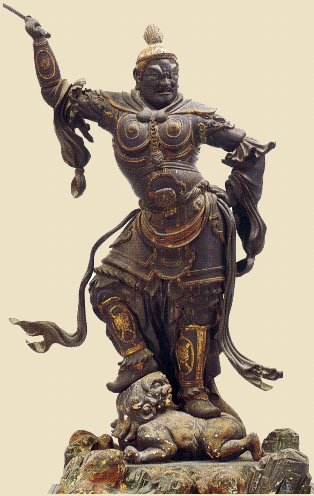
Zōchōten 増長天
Painted Wood, Height = 135.1 cm
Dated to early Kamakura era, 13th century
Mt. Kōya 高野山, Kongōbuji Temple 金剛峰寺
Originally located at Todaiji (Tōdaiji) Temple 東大寺
Photo Source = Vol. 10 日本の仏像
|
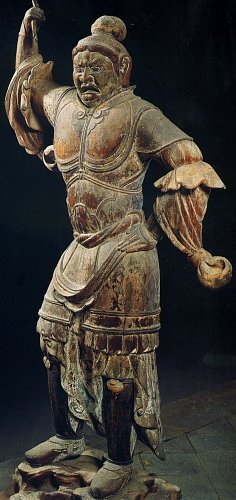
Zōchōten 増長天
Height = 187.2 cm, Wood and Dry Lacquer
Nara Era (Late 8th century), Tōshōdaiji Temple 唐招提寺
Photo Source = Vol. 13 日本の仏像
|
|

Zōchōten 増長天, H = 300 cm
Dated to Nara Era, 8th Century, Hollow Dry Lacquer
Todaiji (Tōdaiji) Temple 東大寺
Photo = Comprehensive Dictionary Japan's Nat'l Treasures
国宝大事典 (西川 杏太郎) ISBN 4-06-187822-0 |
Zōchōten 増長天, H = 184.2 cm, Wood
Dated to Heian Era, 839 AD
Toji (Tōji) Temple 東寺, Kyoto
Photo Source = Vol. 4 日本の仏像 |
|

|
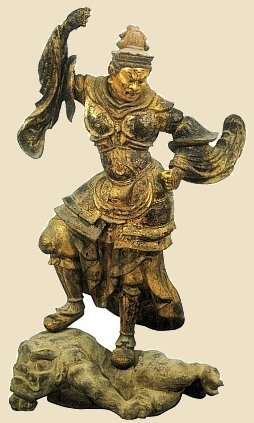
Zōchōten 増長天, Wood, 12th Century
Chūsonji 中尊寺 Temple in Iwate Prefecture
|
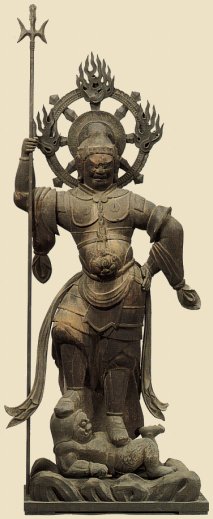
Zōchōten 増長天, H = 93 cm, Wood with Pigment
Heian Era 11th-12th Century, Hōryūji Temple 法隆寺 in Nara
|
|

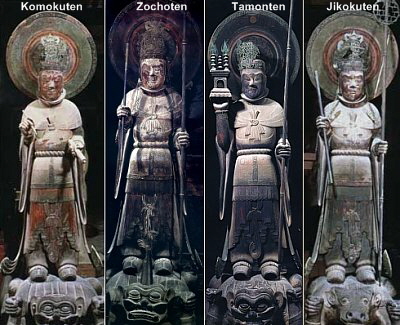
Four Shitenno, Horyuji (Hōryūji) Temple 法隆寺, Nara
Mid-7th Century. Oldest extant set of the four.
Kōmokuten 広目天, Zōchōten 増長天, Tamonten 多門天, Jikokuten 持国天
Painted Wood, Each Statue Approx. 133.5 cm in Height
Photos from Comprehensive Dictionary of Japan's Nat’l Treasures
国宝大事典 (西川 杏太郎. ISBN 4-06-187822-0.

JYAKI (JAKI) DEMON - 邪鬼
In Japan, the Four Shitennō Guardians are almost always shown stepping on evil demons called Jyaki or Tentōki. This iconography symbolizes the power of the Shitennō to repel and defeat evil.
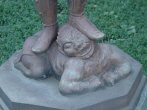 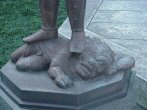 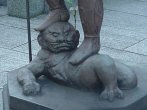
Jaki (Jyaki) at Hase Dera in Kamakura (click any image to enlarge)
Click here for more details about the Jyaki demons.
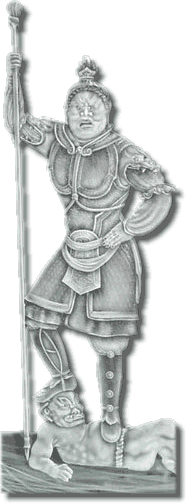
Contemporary etching (glass) of the
8th century statue at Tōdaiji Temple 東大寺 in Nara
Courtesy: www.atomic77.net/5company/2003_6.html

LEARN MORE
- Buddhist-Artwork.com, our sister estore, offers statues of the Shitennō.
- Shitennō, Four Heavenly Kings. Four Deva Kings. Guardians of East, West, North, South (the four cardinal directions). The Shitennō are also associated with four legendary creatures of Chinese mythology (dragon, red bird, tiger, turtle). See Shijin (Four Celestial Emblems) for more on these four creatures.
- In the Japanese Mandala, the Shitennō (Guardians of the Four Directions) are typically shown, from the top, starting with the eastern guardian. Thus, the typical order is Jikokuten (East), Zōchōten (South), Kōmokuten (West), and Tamonten (North).
- 28 Constellations, 28 Moon Lodges, 28 Moon Stations (this site)
Learn more about each of the four quarters (north, south, east, west) and the seven constellations in each group. All 28 represent points in the moon’s monthly path, and each was deified.
- Butsuzō-zu-i 仏像図彙, the “Collected Illustrations of Buddhist Images.” Published in 1690. One of Japan’s first major studies of Buddhist iconography. Hundreds of pages and drawings, with deities classified into approximately 80 (eighty) categories. Modern-day reprints of the expanded Meiji-era version are available at this online store (J-site).
- Mandara Zuten 曼荼羅図典 (Japanese Edition). The Mandala Dictionary. 422 pages. First published in 1993. Publisher Daihorinkaku 大法輪閣. Language Japanese. ISBN-10: 480461102-9. Available at Amazon.
- JAANUS. Japanese Architecture & Art Net Users System. Compiled by the late Dr. Mary Neighbour Parent; covers both Buddhist and Shintō deities in great detail and contains over 8,000 entries.
- A Dictionary of Chinese Buddhist Terms. With Sanskrit & English Equivalents. Plus Sanskrit-Pali Index. By William Edward Soothill & Lewis Hodous. Hardcover, 530 pages. Published by Munshirm Manoharlal. Reprinted March 31, 2005. ISBN 8121511453.
- Digital Dictionary of Chinese Buddhism (C. Muller; login "guest")
- Buddhism: Flammarion Iconographic Guides, by Louis Frederic, Printed in France, ISBN 2-08013-558-9, First published 1995.
- 4 Heavenly Kings, Great Mandala Study Group (outside link). Also see Four Heavenly Kings, Nichiren Tradition (outside link). “They appear in the ceremony of the Lotus Sutra with their 10,000 retainer gods in the Dharani (26th chapter). Therein, Jikokuten and Bishamonten pledge on behalf of all four to protect those who embrace the Lotus Sutra.
- Four Heavenly Kings (J-site, outside link), plus Sanskrit characters used herein.
- See Bibliography for our complete list of resources on Japanese Buddhism.

|
|